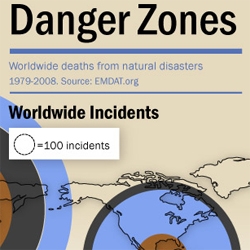HomeownersInsurance.org's Danger Zones - Worldwide Deaths from Natural Disasters (Infographic)
HomeownersInsurance.org has released an infographic displaying the past 30 years of worldwide deaths from natural disasters, sorted by continent.

Roanoke, VA, April 22, 2010 --(PR.com)-- HomeownersInsurance.org has released an infographic displaying the past 30 years of worldwide deaths from natural disasters, sorted by continent.
Danger Zones (Infographic)
The data, collected by the Center for Research on the Epidemiology of Disasters (CRED) and available online at The International Disaster Database (EM-DAT), shows the vast majority of deaths caused by natural disasters in the last 30 years occurred in Asia and Africa. CERD estimates that in the year 2003, 1 in 25 people worldwide was affected by natural disasters.
Drought was the deadliest natural disaster in that time period, responsible for more than 550,000 deaths since 1979. Nearly all deaths related to drought occurred in Africa, with more than 300,000 of those deaths attributed to the devastating famines in Ethiopia in the mid-eighties.
Overall, more than 2 million deaths have been attributed to natural disasters since 1979, with Asia suffering the heaviest losses. Earthquakes, tsunamis, floods and storms all killed more people in Asia than on any other continent. Droughts and epidemics were deadliest in Africa, while extreme temperature was deadliest in Europe.
Along with Ethiopia, other countries hit hardest by natural disasters include Bangladesh (190,000 deaths), China (145,000), India (139,000), Indonesia (188,000), Mozambique (104,000), Myanmar (139,000) and Sudan (160,000). A small number of countries claimed zero deaths from natural disasters in the past thirty years, including Czechoslovakia, Iceland, Montenegro and Serbia.
The data also suggests a striking increase in the number of reported natural disasters around the world. For example, in 1980 CRED lists 148 reported natural disasters worldwide. By 2008, that number had increased to 395. Further, CRED claims “the economic cost associated with natural disasters has increased 14-fold since the 1950s.”
While scientists’ ability to monitor and accurately classify natural disasters may account for some of that increase, CRED asserts that humanity’s impact on the environment plays a distinct role in both the higher number and greater severity of natural disasters. Whether it’s deforestation leading to massive flooding in Bangladesh or “global dimming” and political upheaval leading to extreme famines in Ethiopia, it’s clear that the footprint humans have left on Earth can have dire consequences on the severity of natural disasters.
###
Danger Zones (Infographic)
The data, collected by the Center for Research on the Epidemiology of Disasters (CRED) and available online at The International Disaster Database (EM-DAT), shows the vast majority of deaths caused by natural disasters in the last 30 years occurred in Asia and Africa. CERD estimates that in the year 2003, 1 in 25 people worldwide was affected by natural disasters.
Drought was the deadliest natural disaster in that time period, responsible for more than 550,000 deaths since 1979. Nearly all deaths related to drought occurred in Africa, with more than 300,000 of those deaths attributed to the devastating famines in Ethiopia in the mid-eighties.
Overall, more than 2 million deaths have been attributed to natural disasters since 1979, with Asia suffering the heaviest losses. Earthquakes, tsunamis, floods and storms all killed more people in Asia than on any other continent. Droughts and epidemics were deadliest in Africa, while extreme temperature was deadliest in Europe.
Along with Ethiopia, other countries hit hardest by natural disasters include Bangladesh (190,000 deaths), China (145,000), India (139,000), Indonesia (188,000), Mozambique (104,000), Myanmar (139,000) and Sudan (160,000). A small number of countries claimed zero deaths from natural disasters in the past thirty years, including Czechoslovakia, Iceland, Montenegro and Serbia.
The data also suggests a striking increase in the number of reported natural disasters around the world. For example, in 1980 CRED lists 148 reported natural disasters worldwide. By 2008, that number had increased to 395. Further, CRED claims “the economic cost associated with natural disasters has increased 14-fold since the 1950s.”
While scientists’ ability to monitor and accurately classify natural disasters may account for some of that increase, CRED asserts that humanity’s impact on the environment plays a distinct role in both the higher number and greater severity of natural disasters. Whether it’s deforestation leading to massive flooding in Bangladesh or “global dimming” and political upheaval leading to extreme famines in Ethiopia, it’s clear that the footprint humans have left on Earth can have dire consequences on the severity of natural disasters.
###
Contact
Homeowners Insurance
Raymond Hansen
540-631-0505
www.homeownersinsurance.org
Raymond Hansen
540-631-0505
www.homeownersinsurance.org
Categories

